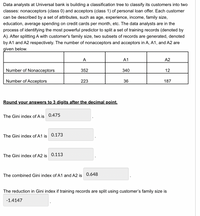
MATLAB: An Introduction with Applications
6th Edition
ISBN: 9781119256830
Author: Amos Gilat
Publisher: John Wiley & Sons Inc
expand_more
expand_more
format_list_bulleted
Question
i got three wrong but I am not sure which ones

Transcribed Image Text:Data analysts at Universal bank is building a classification tree to classify its customers into two
classes: nonacceptors (class 0) and acceptors (class 1) of personal loan offer. Each customer
can be described by a set of attributes, such as age, experience, income, family size,
education, average spending on credit cards per month, etc. The data analysts are in the
process of identifying the most powerful predictor to split a set of training records (denoted by
A). After splitting A with customer's family size, two subsets of records are generated, denoted
by A1 and A2 respectively. The number of nonacceptors and acceptors in A, A1, and A2 are
given below.
А
A1
A2
Number of Nonacceptors
352
340
12
Number of Acceptors
223
36
187
Round your answers to 3 digits after the decimal point.
The Gini index of A is 0.475
The Gini index of A1 is 0.173
The Gini index of A2 is 0.113
The combined Gini index of A1 and A2 is 0.648
The reduction in Gini index if training records are split using customer's family size is
-1.4147
Expert Solution
This question has been solved!
Explore an expertly crafted, step-by-step solution for a thorough understanding of key concepts.
This is a popular solution
Trending nowThis is a popular solution!
Step by stepSolved in 2 steps

Follow-up Questions
Read through expert solutions to related follow-up questions below.
Follow-up Question
Are you able to assist me with the last two questions?
Solution
by Bartleby Expert
Follow-up Questions
Read through expert solutions to related follow-up questions below.
Follow-up Question
Are you able to assist me with the last two questions?
Solution
by Bartleby Expert
Knowledge Booster
Similar questions
- A manager has 4 people that can play any of positions. How many different way's can he assign these spots?arrow_forwardFind the number of different ways that an instructor can choose 7 students from a class of 23 students for a field trip.arrow_forwardOf 12 possible books, you plan to take 6 with you on vacation. How many different collections of 6 books can you take? You can take different collections of 6 books on vacation with you.arrow_forward
- What is the Combination Rule?arrow_forwardFind the number of different ways that an instructor can choose 4 students from a class of 18 students for a field trip.arrow_forwardThere are 3 songs in a playlist. How many ways are there to order and play them one by one? Each song will only be played once and only once?arrow_forward
- There are 10 student clubs on campus. You want to join 2 of them this year. How many ways that you can choose 2 clubs to join out of 10?arrow_forwardA combination has 3 characters. The first is a letter(26 letters A-Z), The second and third characters are numbers 0-9, but cannot repeat the same number. How many possible combinations are there?arrow_forwardThere are 2 songs in a playlist. How many ways are there to order and play them one by one? Each song will only be played once and only once?arrow_forward
- How did you get the values in the able?arrow_forwardThe call letters for radio stations begin with K or W, followed by 3 additional letters. How many sets of call letters having 4 letters are possible?arrow_forwardFind the number of different ways that an instructor can choose 7 students from a class of 14 students for a field trip.arrow_forward
arrow_back_ios
arrow_forward_ios
Recommended textbooks for you
 MATLAB: An Introduction with ApplicationsStatisticsISBN:9781119256830Author:Amos GilatPublisher:John Wiley & Sons Inc
MATLAB: An Introduction with ApplicationsStatisticsISBN:9781119256830Author:Amos GilatPublisher:John Wiley & Sons Inc Probability and Statistics for Engineering and th...StatisticsISBN:9781305251809Author:Jay L. DevorePublisher:Cengage Learning
Probability and Statistics for Engineering and th...StatisticsISBN:9781305251809Author:Jay L. DevorePublisher:Cengage Learning Statistics for The Behavioral Sciences (MindTap C...StatisticsISBN:9781305504912Author:Frederick J Gravetter, Larry B. WallnauPublisher:Cengage Learning
Statistics for The Behavioral Sciences (MindTap C...StatisticsISBN:9781305504912Author:Frederick J Gravetter, Larry B. WallnauPublisher:Cengage Learning Elementary Statistics: Picturing the World (7th E...StatisticsISBN:9780134683416Author:Ron Larson, Betsy FarberPublisher:PEARSON
Elementary Statistics: Picturing the World (7th E...StatisticsISBN:9780134683416Author:Ron Larson, Betsy FarberPublisher:PEARSON The Basic Practice of StatisticsStatisticsISBN:9781319042578Author:David S. Moore, William I. Notz, Michael A. FlignerPublisher:W. H. Freeman
The Basic Practice of StatisticsStatisticsISBN:9781319042578Author:David S. Moore, William I. Notz, Michael A. FlignerPublisher:W. H. Freeman Introduction to the Practice of StatisticsStatisticsISBN:9781319013387Author:David S. Moore, George P. McCabe, Bruce A. CraigPublisher:W. H. Freeman
Introduction to the Practice of StatisticsStatisticsISBN:9781319013387Author:David S. Moore, George P. McCabe, Bruce A. CraigPublisher:W. H. Freeman

MATLAB: An Introduction with Applications
Statistics
ISBN:9781119256830
Author:Amos Gilat
Publisher:John Wiley & Sons Inc

Probability and Statistics for Engineering and th...
Statistics
ISBN:9781305251809
Author:Jay L. Devore
Publisher:Cengage Learning

Statistics for The Behavioral Sciences (MindTap C...
Statistics
ISBN:9781305504912
Author:Frederick J Gravetter, Larry B. Wallnau
Publisher:Cengage Learning

Elementary Statistics: Picturing the World (7th E...
Statistics
ISBN:9780134683416
Author:Ron Larson, Betsy Farber
Publisher:PEARSON

The Basic Practice of Statistics
Statistics
ISBN:9781319042578
Author:David S. Moore, William I. Notz, Michael A. Fligner
Publisher:W. H. Freeman

Introduction to the Practice of Statistics
Statistics
ISBN:9781319013387
Author:David S. Moore, George P. McCabe, Bruce A. Craig
Publisher:W. H. Freeman